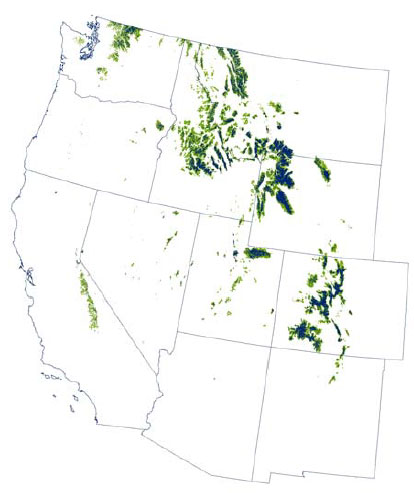With a solitary nature and a strong survival instinct, the wolverine is an icon of arctic and alpine environments. Wolverines have been extirpated from Colorado, but Colorado Parks & Wildlife is in discussions with partners and stakeholders about the potential to restore this species to Colorado’s High Country.
 The wolverine (Gulo gulo) is the largest member of the weasel (mustelid) family. With short, rounded ears, a broad head and a stocky body, wolverines are sometimes mistaken for small bears. Their tails, however, are bushy and relatively long. Their feet are large and during the winter have stiff hairs that aid in insulation and walking on top of the snow. Wolverines have unique coloration and markings: they are medium to dark brown with broad yellowish brown stripes down their sides and across the forehead. Males are larger than females, and full-grown adults in the lower 48 states typically weigh about 25-35 pounds (less than a blue heeler); adults are 3 to 3 ½ feet long.
The wolverine (Gulo gulo) is the largest member of the weasel (mustelid) family. With short, rounded ears, a broad head and a stocky body, wolverines are sometimes mistaken for small bears. Their tails, however, are bushy and relatively long. Their feet are large and during the winter have stiff hairs that aid in insulation and walking on top of the snow. Wolverines have unique coloration and markings: they are medium to dark brown with broad yellowish brown stripes down their sides and across the forehead. Males are larger than females, and full-grown adults in the lower 48 states typically weigh about 25-35 pounds (less than a blue heeler); adults are 3 to 3 ½ feet long. Do Wolverines Live In Colorado?
 There once was a viable population of wolverine in the state, however the last confirmed record was from 1919. Twelve survey efforts from 1979-1996 yielded no confirmed sightings. Colorado’s high elevation and rugged terrain were and are good wolverine habitat, but because the species naturally exists in extremely low numbers wherever it is found, the species was never numerous here. In 2009, researchers from Grand Teton National Park tracked a wolverine into northcentral Colorado. It is estimated that Colorado has the potential to support approximately 100 animals at full carrying capacity. Because the animal needs large areas of cold, rocky habitat, the vast majority of land where the animal would live occurs on high-elevation public lands.
There once was a viable population of wolverine in the state, however the last confirmed record was from 1919. Twelve survey efforts from 1979-1996 yielded no confirmed sightings. Colorado’s high elevation and rugged terrain were and are good wolverine habitat, but because the species naturally exists in extremely low numbers wherever it is found, the species was never numerous here. In 2009, researchers from Grand Teton National Park tracked a wolverine into northcentral Colorado. It is estimated that Colorado has the potential to support approximately 100 animals at full carrying capacity. Because the animal needs large areas of cold, rocky habitat, the vast majority of land where the animal would live occurs on high-elevation public lands.
Wolverine Distribution & Habitat
Wolverines currently are widely distributed in Canada and Alaska, with smaller populations in the lower 48 United States in Montana, Idaho and Wyoming. In the northern part of their range, they occur within a wide variety of arctic, subarctic and alpine habitats. In the contiguous United States, wolverines are restricted to high-elevation habitats in the Rocky Mountains containing the arctic and subarctic conditions they require. It is estimated that there are fewer than 400 animals in the contiguous United States. Wolverines require large areas of suitable, high elevation habitat. They are solitary, territorial animals and have large home ranges. In the Yellowstone Region, female home ranges average over 150 square miles and males nearly 500 square miles. Wolverines can travel large distances over extremely rough terrain and deep snow. Individual wolverines may move over 30 km (18 miles) in one night.
What do Wolverines Eat?
Wolverines are opportunistic feeders and eat a variety of foods that are available in their harsh alpine environment: small rodents, rabbits, porcupines, ground squirrels, marmots, birds and eggs, fish, carrion, and plants. Wolverines will occasionally eat deer and other large ungulates. These are probably scavenged, although wolverines are able to kill large ungulates if those animals are weakened and bogged in deep snow. In the wintertime, the diet of wolverines is mostly carrion and mammalian prey, with higher diversity at other times of the year.
Wolverine Life Cycle
Wolverines are most active during morning and evening and do not hibernate. They are solitary animals, pairing only during the brief mating season. Breeding occurs during summer, however, females do not give birth until the winter. Litter sizes are small, typically two to three cubs. They give birth in dens that are typically in the debris pile at the base of an avalanche chute and buried under deep snow cover. Reproductive success is very low, in part due to loss of cubs, and because most females are not reproductively mature until at least three to four years of age. Young stay with the female through the summer and into the fall when they are nearly full-grown. Natural predators of wolverine include bears, cougars, and wolves. The typical lifespan of an animal in the wild is six to ten years. Maximum age is thought to be less than 15 years.

